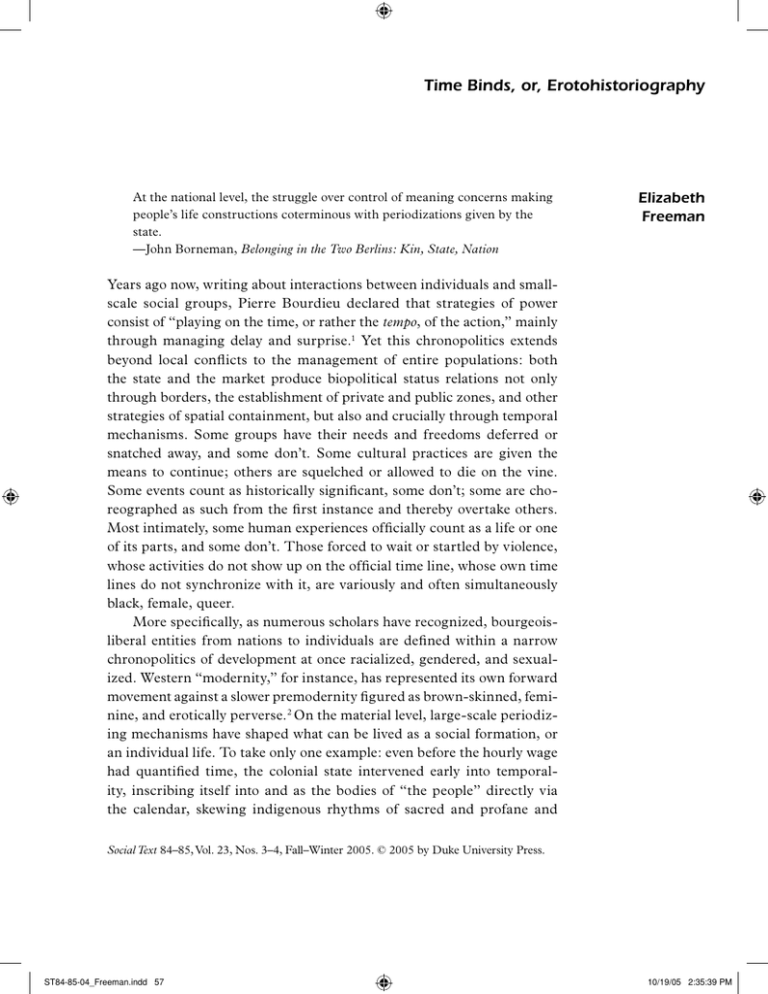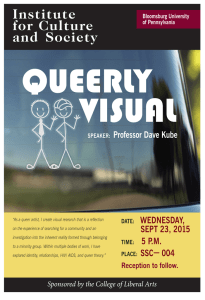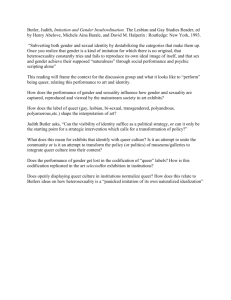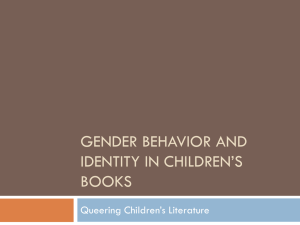
Time Binds, or, Erotohistoriography
At the national level, the struggle over control of meaning concerns making
people’s life constructions coterminous with periodizations given by the
state.
—John Borneman, Belonging in the Two Berlins: Kin, State, Nation
Elizabeth
Freeman
Years ago now, writing about interactions between individuals and smallscale social groups, Pierre Bourdieu declared that strategies of power
consist of “playing on the time, or rather the tempo, of the action,” mainly
through managing delay and surprise.1 Yet this chronopolitics extends
beyond local conflicts to the management of entire populations: both
the state and the market produce biopolitical status relations not only
through borders, the establishment of private and public zones, and other
strategies of spatial containment, but also and crucially through temporal
mechanisms. Some groups have their needs and freedoms deferred or
snatched away, and some don’t. Some cultural practices are given the
means to continue; others are squelched or allowed to die on the vine.
Some events count as historically significant, some don’t; some are choreographed as such from the first instance and thereby overtake others.
Most intimately, some human experiences officially count as a life or one
of its parts, and some don’t. Those forced to wait or startled by violence,
whose activities do not show up on the official time line, whose own time
lines do not synchronize with it, are variously and often simultaneously
black, female, queer.
More specifically, as numerous scholars have recognized, bourgeoisliberal entities from nations to individuals are defined within a narrow
chronopolitics of development at once racialized, gendered, and sexualized. Western “modernity,” for instance, has represented its own forward
movement against a slower premodernity figured as brown-skinned, feminine, and erotically perverse. 2 On the material level, large-scale periodizing mechanisms have shaped what can be lived as a social formation, or
an individual life. To take only one example: even before the hourly wage
had quantified time, the colonial state intervened early into temporality, inscribing itself into and as the bodies of “the people” directly via
the calendar, skewing indigenous rhythms of sacred and profane and
Social Text 84–85, Vol. 23, Nos. 3–4, Fall–Winter 2005. © 2005 by Duke University Press.
ST84-85-04_Freeman.indd 57
10/19/05 2:35:39 PM
representing these rhythms as backward and superstitious. 3 And, as John
Borneman suggests in my epigraph, supposedly postimperial nation-states
still track and manage their own denizens through an official time line,
effectively shaping the contours of a meaningful life by registering some
events like births, marriages, and deaths, and refusing to record others
like initiations, friendships, and contact with the dead.4 In many places,
the neoliberalist project continues to reconstruct time in these ways as it
“develops” new regions for profit, and additionally depends upon the idea
of capital’s movement as itself an inexorable progress that will eventually
accommodate select women, people of color, and queers. Neoliberalism
describes the needs of everyone else, everyone it exploits, as simply, generically, deferred: the phrase “No Child Left Behind” suggests that there is,
indeed, a behind in which the unlucky shall dwell.
Homi Bhabha has elegantly described this unheimlich “place” of anteriority, where in the postcolony time is always several and any historical
moment correspondingly consists of many.5 But it is also a crucial one
within which queer politics and theory must dismantle the chronopolitics of
development. If in 1990 or so, “queer” named a pressure against the state’s
naming apparatus, particularly against the normalizing taxonomies of male
and female, heterosexual and homosexual, now it must include pressure
against state and the market periodizing apparatuses.6 I say “queer” not to
overwrite postcolonial theory with a singular focus on sexuality—indeed,
there is an emerging body of powerful work on the intersection of these two
domains. Rather, my version of queer insists, following Cesare Casarino,
that “we need to understand and practice time as fully incorporated, as
nowhere existing outside of bodies and their pleasures.” 7 Thus while this
essay argues for a deviant chronopolitics obviously indebted to the work
of postcolonial thinkers, it also insists that pleasure is central to the project—that queers survive through the ability to invent or seize pleasurable
relations between bodies. We do so, I argue, across time.
I also emphasize a Foucauldian notion of pleasure and bodily contact
over a Freudian model of pain and ego formation in response to recent
reevaluations of negative affect in queer theory. So far, a simultaneously
psychoanalytic and historicist loss—perhaps replacing or subsuming structuralist lack—has emerged as one of fin de siècle queer theory’s key terms.
A number of scholars have tracked the way that queer subjectivity and
collectivity demand, and take as their reward, particularly inventive and
time-traveling forms of grief and compensation that neither the normalizing work of the ego nor the statist logic of sequential generations can
contain. 8 I would like to suggest, however, that this powerful turn toward
loss—toward failure, shame, negativity, grief, and other structures of
58
ST84-85-04_Freeman.indd 58
Elizabeth Freeman
10/19/05 2:35:40 PM
feeling historical—may also be a premature turn away from a seemingly
obsolete politics of pleasure that could, in fact, be renewed by attention to
temporal difference. That is, melancholic queer theory may acquiesce to
the idea that pain—either a pain we do feel or a pain we should feel but
cannot, or a pain we must laboriously rework into pleasure if we are to
have any pleasure at all—is the proper ticket into historical consciousness.
Eroticism and materialist history, pleasure and the dialectic, are too often
cast as theoretical foils: was it not the distinctly unqueer Fredric Jameson
who wrote, albeit in a very different context, that “history is what hurts.
It is what refuses desire”? 9 Perhaps theorizing queerness on the basis of
grief and loss acquiesces, however subtly, to a Protestant ethic in which
pleasure cannot be the grounds of anything productive at all, let alone of
such a weighty matter as the genuinely historical.
Against the chronopolitics of development, and also extending postcolonial notions of temporal heterogeneity beyond queer melancholic historiography, this essay advances what I call erotohistoriography: a politics
of unpredictable, deeply embodied pleasures that counters the logic of
development. Particularly in light of the liberal transformation of a queer
sex revolution into gay marriage reform and Marxist condemnations of
queer theory’s focus on matters libidinal,10 I would like to take the risk of
the inappropriate response to ask: how might queer practices of pleasure,
specifically, the bodily enjoyments that travel under the sign of queer sex,
be thought of as temporal practices, even as portals to historical thinking?
Freud’s “uncanny” has offered one powerful model for a dialectic between
bodily feelings and temporal alterity, but its “feelings” are both unpleasant
and at one remove from the body (with the exception of goose bumps).
Perhaps more important, the productive sense of alternate times in the
uncanny—so fruitful for postcolonial theory—centers on the distinctly
heterosexualized chronotopes of home, family, and mother.11 In contrast,
Foucault has famously written that queers should “use sexuality henceforth
to arrive at a multiplicity of relationships,” while Bourdieu would insist
that these relationships inevitably play with and on time.12 As a mode of
reparative criticism, then, erotohistoriography indexes how queer relations
complexly exceed the present. It insists that various queer social practices,
especially those involving enjoyable bodily sensations, produce form(s) of
time consciousness, even historical consciousness, that can intervene upon
the material damage done in the name of development.13 Against pain and
loss, erotohistoriography posits the value of surprise, of pleasurable interruptions and momentary fulfillments from elsewhere, other times.
Against pain and
Erotohistoriography
59
ST84-85-04_Freeman.indd 59
loss, erotohistoriography
posits the value
of surprise, of
pleasurable
interruptions
and momentary
fulfillments from
elsewhere,
other times.
10/19/05 2:35:40 PM
Bind Me Up, Bind Me Down
Were I a writer, and dead, how I would love it if my life, through the pains
of some friendly and detached biographer, were to reduce itself to a few
details, a few preferences, a few inflections, let us say: to “biographemes”
whose distinction and mobility might come to touch, like Epicurian atoms,
some future body, destined to the same dispersion.
—Roland Barthes, Sade, Loyola, Fourier
As a way in, let me momentarily exhume a body all too familiar to queer
theory, particularly the literary-critical sort: Frankenstein’s monster. The
monster’s physique, a patchwork of remnants from corpses his creator
robs from the grave, is itself an index of temporal nonsynchronicity—specifically, of dead bodies persisting in the present and the future, of nonreproductive, yet still insistently corporeal kinship with the departed. His
body literalizes Carolyn Dinshaw’s model of the queer touch of time, of
past bodies palpably connecting with present ones.14 But in a low-budget
independent film I saw a few years ago, Frankenstein’s monster momentarily appeared to suggest the possibility of a sensual connection with
futurity as well. In Hillary Brougher’s 1997 The Sticky Fingers of Time,
a woman mentions a scene in a novel her best friend has written: “I love
that part, when Frankenstein splits his stitches and he dies, fertilizing the
earth where that little girl grows tomatoes.”15 In contrast to the original
novel, here the monster secures his future, joining the human scheme of
obligations and dependencies rather than escaping on an ice floe. Though
he seems to inseminate the little girl (for his body fluids will indirectly
enter the orifice of her mouth when she eats the tomatoes), he transcends
both the supposedly natural pain of childbirth and the cyclical time of
reproduction. Like Walt Whitman, he disseminates himself.16 Together,
his body and the act he performs with it suggest a historiographical practice wherein the past takes the form of something already fragmented,
“split,” and decaying, and the present and future appear equally porous.
Indeed, they seem to answer Roland Barthes’s call, in my second epigraph, for a model of dispersed but insistently carnal continuity,17 which
I call binding. In this sense, the monster’s body is not a “body” at all but
a figure for relations between bodies past and present, for the insistent
return of a corporealized historiography and future making of the sort to
which queers might lay claim.
The scene that this woman calls forth, then, figures almost everything
I mean by this essay’s title “Time Binds.” At the simplest level, “binds”
are predicaments: like Frankenstein’s monster, we cannot reproduce little
queers with sperm and eggs, even if we do choose to give birth or parent:
60
ST84-85-04_Freeman.indd 60
Elizabeth Freeman
10/19/05 2:35:41 PM
making other queers is a social matter. In fact, sexual dissidents must create continuing queer lifeworlds while not being witness to this future or
able to guarantee its form in advance, on the wager that there will be more
queers to inhabit such worlds: we are “bound” to queer successors whom
we might not recognize. “Binds” also suggests the bonds of love, not only
attachments in the here and now but also those forged across both spatial
and temporal barriers: to be “bound” is to be going somewhere. Yet even
as it suggests connectivity, “binds” also names a certain fixity in time, a
state of being timebound, belated, incompletely developed, left behind or
not there yet, going nowhere. This nowhere has everything to do with sex,
for “binds” is the present-tense English of a German verb employed by
Freud, Binden, meaning to contain otherwise freely circulating libidinal
energies. Yet there are pleasures here, too, for “binding” is, of course, one
among many queer bodily practices, which include not only the painful
enjoyment of bondage but also, in the scene I have described, the digestive
work the little girl’s body will eventually do upon the tomatoes.
Binding, we might say, makes predicament into pleasure, fixity into
a mode of travel across time as well as space. Like “dissemination,” it
counters the fantasy of castration that subtends melancholic historiography, for it foregrounds attachments rather than loss. Furthermore, the
monster’s body and bodily act provide a queer alternative to the two most
heterosexually gendered figures for “progress”: the fecund maternal body
that supposedly engenders natural history and the heroic male body that
supposedly engenders national history. Consider the monster in terms
of Freud’s theory that a bodily imago and eventually the ego itself bind,
indeed are caused by the binding of, raw and unpleasant sensory effects
into legible somatic and psychic form. Freud argues that subjectivity begins
when the libido invests in an uncomfortable bodily sensation by means
of which it doubles back upon itself to delineate body parts as such. His
example is a toothache, though he suggests that the genitals are perhaps
the most insistent locale for such libidinal fixations.18 From within this
Möbius loop of attachment to sensitive areas, an increasingly unified sense
of bodily contours emerges, and these contours materialize the ego that
is “at first, a bodily ego,” an interconnected set of perceived surfaces and
boundaries.19 Opening these terms out into the social, we can certainly
think of engroupment—the collective form of the ego—as engendered
by just this process. Here, the monster’s wounds become metonymic of
any number of physical lacerations suffered by queer bodies: beatings,
unwanted heterosexual sex, medical “corrections” to the intersexed. These
injuries, among others, are the violent foundation of collective queer being,
the morphological imaginary, as Judith Butler calls it, for a wounded socius
whose very wounding enables its being at all. 20
Erotohistoriography
ST84-85-04_Freeman.indd 61
61
10/19/05 2:35:42 PM
History thus
emerges
as textual,
humanmade,
and linear only in
contradistinction
to a mute female
body laboring
“naturally” and
recurrently in
childbirth.
62
ST84-85-04_Freeman.indd 62
But even the scene as I have narrated it thus far succumbs to the logic
that time binding would counter. As L. O. Aranye (Louise) Fradenburg
has argued, history, coded as male, supersedes reproduction, coded as
female, insofar as the former charts the work of men injured in war who
tell tales to one another across generations. 21 History thus emerges as textual, humanmade, and linear only in contradistinction to a mute female
body laboring “naturally” and recurrently in childbirth. In The Sticky
Fingers of Time, within a conversation between two women, the singular
and irreplaceable event of a wounded male body installs the deep time
of a “before” and an “after,” marks the potential historicity of this time
and facilitates human agency over it in the form of a narrative that our
fictional writer hands over to her friend and she hands over to the filmic
audience. Significantly, one speaker is murdered soon after the conversation, suggesting that two women cannot be the bearers of a future thought
outside the context of reproduction. Or, this is what you get when you look
at the speakers and not at the little girl who does not actually materialize
in this scene: as a figure for the queer undead, the monster is temporally
linked—timebound—to the little girl who is not a child at all but a queer
unborn, a future we cannot see but upon which we bet. Her speculated
presence, I would argue, inaugurates a different reading of the monster,
one leading to the “eroto-” in erotohistoriography.
Returning to Fradenburg’s and Freud’s analyses, both pivot on the
transformation of a wound into phallic power. Authority over what counts
as history, Fradenburg argues, compensates for bodily injury. As Butler
has noted, Freud eventually recasts the originary bodily discomfort that
creates the individual (and I would argue, social) imago as a tumescence
or engorgement, the kind that only penises experience. Part of Butler’s
project is to unglue the phallic ego from the penis by relocating the grounds
for a morphological imaginary, a bodily ego, onto any number of possible
bodily surfaces: the lesbian phallus might emerge in relation to “an arm,
a tongue, a hand (or two), a knee, a thigh, a pelvic bone, an array of purposefully instrumentalized body-like things.” 22 But where in this model is
the toothache’s interestingly aching hole and other symptoms of a certain
desire to be filled up, not all of which can be reduced to wounds? What
is the morphological imaginary for that? Another essay about the lesbian
phallus allows us to see that the Freudian hole seems to reappear in Butler’s
work on and as the audience. Jordana Rosenberg has recently argued that
in Butler’s essay, the audience’s hunger for lesbian presence, the dumb
literalist dyke’s wish to be taken by the clumsy, dildonic visual referent,
can only disgust and amuse the professional deconstructionist for whom
the phallus is, of course, the very sign of nonpresence. 23 Our monster’s
extravagant bodily gesture similarly relocates the hole: the little girl, his
Elizabeth Freeman
10/19/05 2:35:42 PM
“audience,” will have her hunger satiated directly by the tomato and indirectly by his blood, which also carries with it the DNA of multiple dead. Of
course, her queer hunger for tactile contact with the past is open to similar
charges of vulgar historicism, the ugly twin of vulgar homosexuality. But
the monster’s wounds themselves pass over from his pain to her satisfaction, his openings to hers, without necessarily having to become either lack
or presence. The monster’s transfer of energy across time appears not as
masculine sacrifice but rather as a gender-undifferentiated but nevertheless
localized bodily effusion: in short, holes beget holes.
The great surprise of this scene, then, lies in the missing feast it suggests: a taste of the idea that pleasure may be as potentially generative of
a future as pain, trauma, loss, or foreclosure. In fact, Giorgio Agamben
has suggested that pleasure could found a new concept of time, one presently missing from historical materialism. But he has more problematically
located that pleasure in “man’s originary home,” which sounds, again, like
a return to the plenitude of a maternal body. 24 In contrast, the scene I have
described offers neither mother nor father in its imagining of relations
across time and between times, no original womb, but only a scarred and
striated body on the one side, an absent prepubescent body on the other,
and a dumb, juicy, not-yet-born vegetable in between, with no portable
text mediating the transfer. And, crucially, it offers the mouth as a tactile
rather than just a verbal instrument for temporal transactions, for temporal
binding. The question is how this might become historical.
Surprise! On the Inappropriate Response
In its recorporealizing of the mouth and its use of this “hole” to bind
a differential past to an uninevitable future, the figure of the little girl
invokes Nicholas Abraham and Maria Torok’s description of melancholia—one that has the power to reinscribe pleasure into the melancholic
historiographical interventions that queer theory is already making. Abraham and Torok describe melancholia in particularly corporeal terms, as a
way to preserve a prior scene or object in the form of a symptom usually
connected to the mouth—sometimes a set of behaviors like bingeing on
food or starving, but most often a fetish word, even a way of speaking, that simultaneously preserves and obscures the loss. In this process,
which they call incorporation, the subject mimes its repossession of a
lost object by eating or speaking awry, attempting literally to embed the
object into or make it part of the body itself. 25 Incorporation, Abraham
and Torok argue, is the pathological form of a process they call introjection, where the lost object serves as a means for the subject to rework its
Erotohistoriography
ST84-85-04_Freeman.indd 63
63
10/19/05 2:35:43 PM
In fact, opened
out from
individual psyche
to collective
process, both
the process of
incorporation
and that of
introjection
suggest what
might be called
a “bottom”
historiography.
64
ST84-85-04_Freeman.indd 64
originary erotic autonomy. 26 In introjection, the object becomes a mere
placeholder for the self, whom the subject must return to loving as in
primary narcissisim, but this time the self must be permeable enough to
integrate new objects, too. This is, notably, a much less phallic model of
the ego than Freud’s, or even Butler’s. In fact, opened out from individual
psyche to collective process, both the process of incorporation and that of
introjection suggest what might be called a “bottom” historiography. If
our absent little girl is a receptacle for queer history, what she receives is
not a transmission of authority or custom but a transmission of receptivity
itself, of a certain pleasurably porous relation to new configurations of the
past and unpredictable futures. 27
In Abraham and Torok’s model, melancholia is cured when the lost
object finally disappears, when incorporation yields to introjection, and
time synchs up again such that the uninterrupted present corresponds to
an integrated self open to the future but over the past. Yet like melancholia
itself, the so-called pathological form of incorporation seems eminently
more queer; it preserves the past as past, in a crypt imperfectly sealed off
from the present. Incorporation imagines a psyche with unpredictable leakages, a body at semiotically and sexually productive temporal odds with
itself. Despite Abraham and Torok’s flattening of time in the “normal”
model of introjection, the past they suggest interrupts the present to trigger eating and speaking is not wholly defined in terms of trauma. Instead,
it consists of latent excitations not yet traversed by the binary between
pain and pleasure. In this sense, what is preserved and suspended within
the mouth is also capable of being released as pleasure rather than simply
being repeated as incomplete mastery over pain.
In fact, Torok addresses the most opaque part of Freud’s essay on
mourning and melancholia, in which Freud notes but fails to theorize the
problem of the inappropriate response. While we would expect tears or
numbness in the face of death, Freud remarks that the grieving subject often
experiences a surge of frenzied joy: “The most remarkable peculiarity of
melancholia, and one most in need of explanation, is the tendency it displays
to turn into mania accompanied by a completely opposite symptomatology.”28 He notes that mourning does not have the same tendency, which
eliminates the possibility that mania is simply energy unbound from the lost
object once its loss has been recognized and worked through. Torok considers a series of letters in which Freud’s contemporary Karl Abraham pressed
him to consider the question of this mania and suggested several times that
it often consisted of a sudden influx of erotic feelings. But Freud seems not
to have answered this call to examine the phenomenon. Taking up where
he left off, Torok suggests that the melancholic’s entombed secret may not
be a loss at all. Rather, it is an erotic effusion repressed and mnemonically
Elizabeth Freeman
10/19/05 2:35:44 PM
preserved: “The illness of mourning [i.e., melancholia] does not result, as might
appear, from the affliction caused by the objectal loss itself, but rather from the
feeling of an irreparable crime of having been overcome with desire, of having been
surprised by an overflow of libido at the least appropriate moment, when it would
behoove us to be grieved in despair.”29 She goes on to claim that melancholic
incorporation itself “perpetuate[s] a clandestine pleasure,” a long-ago
interrupted scene of erotic contact with the lost object. 30 For Torok, then,
the melancholic psyche is a doubled effect of pleasures past: first, pleasure
is severed and remade as unpleasure or trauma; then, the object that gave
pleasure itself disappears. The scene’s affect and object secret themselves
in body and psyche, to be released in the grieving subject’s sudden feeling
of carnal desire. In short, as a component of melancholia, mania revisits
an inappropriate sexual response from the past.
With Torok’s sense of melancholia as a lost erotic encounter preserved,
then, we can imagine the “inappropriate” response of eros in the face of
sorrow as a trace of past forms of pleasure located in specific historical
moments. A recent video by Nguyen Tan Hoang, an emerging artist, makes
this possibility tangible: K.I.P. (2002) cuts between a 1970s pornographic
videotape and an image of Nguyen’s face reflected in a television set.
Speaking of this work recently, Nguyen described his fascination with the
way that the original videotape had deteriorated in the places where viewers had rewound the tape to look at particularly sexy scenes, so that the
tape now skipped and the action was punctuated by grainy blank spots. 31
Reappearing in Nguyen’s video, these blank spots suggest the impossibility
of returning to the short-lived era when gay men could have unprotected
sex with multiple partners without fear. Floating over this scene, Nguyen’s
face is the sign of his generation, born too late. At the same time, the
image of Nguyen’s face indexes the fact that, given how Asian American
men have been stereotyped as feminine in the United States, he would not
necessarily have had access anyway to this particular sex scene or to the
“scene” of urban macho man cruising: Nguyen’s reflection also looks like
the ghosts of those condemned to watch from the sidelines during the era
of the taping, waiting for their moment of inclusion. Yet this is not a tape
about inclusion, ultimately, for a trace of pleasure is also visible: the surface
of the television also simply reflects a voyeur taking his enjoyments where
he finds them. Given the historical framing of this video by AIDS and
racism against Asian Americans, it might seem politically inappropriate for
the videomaker-character to experience any bliss by looking at white gay
men barebacking. Yet there he is, watching. The audience cannot know
for sure what personal or political experiences rush into his head to fill
the gaps in the tape that once contained white gay men, to bind him to the
surrounding scenes and bind these to events in his own life.
Erotohistoriography
ST84-85-04_Freeman.indd 65
65
10/19/05 2:35:44 PM
Nguyen’s video registers something akin to Toni Morrison’s concept
of “skin memory, the body’s recollection of pleasure,” combined with the
claim of her earlier works that the skin might index historical moments
as well as personal encounters. 32 But what Abraham and Torok describe
as maniac memory is hardly emotion recollected in tranquillity—instead,
it is an irruption of strange plenitude in the present, like Nguyen’s bliss
amid generational and racial grief. In this and other erotohistoriographical
works, we see Walter Benjamin’s concept of the shock of modernity, which
even he linked to ephemeral encounters with sexualized figures such as
prostitutes and sailors, met by his concept of the past flashing up to illuminate the present. 33 Following the lead of Abraham and Torok, of Benjamin, of works like these two films, we might imagine ourselves haunted
by ecstasy and not just by loss; residues of positive affect (erotic scenes,
utopias, memories of touch) might be available for queer counter- (or
para-) historiographies. As I have argued elsewhere, within this paradigm
we might see camp performance as a kind of historicist jouissance, a friction of dead bodies upon live ones, obsolete constructions upon emergent
ones, which I have called “temporal drag.”34 Or, we might look for what
Annamarie Jagose has called “the figure of ‘history’—its energizing of the
very tropes of before and after” in queer patterns of courtship and cruising,
in sexual and more broadly tactile encounters, even in identity formations
such as butch/femme or FTM. 35 Or (and), historicity itself might appear
as a structure of tactile feeling, a mode of touch, even a sexual practice. In
particular, we may want to glimpse traces of historically specific forms of
pleasure—whether they have been lost, repressed, disavowed, or subsumed
into institutional forms of supposedly benign supervision like marriage—in
our present, precisely because they once counted in the lesbian and gay
imaginary, if not the national one, as part of what it meant to have a life.
Notes
Many thanks to those who offered comments on this essay in its various incarnations: Bishnu Ghosh, Judith Halberstam, Heather Love, Dana Luciano,
H. N. Lukes, Kara Thompson, readers and editors at Social Text, and audiences at
Harvard University, the Pembroke Center for Teaching and Research on Women
at Brown University, and the University of California at Davis Scholars’ Symposium.
1. Pierre Bourdieu, Outline of a Theory of Practice, trans. Richard Nice (New
York: Cambridge University Press, 1977), 7.
2. Exemplary recent critiques of the intertwined racial, gendered, and sexualized politics of developmental time include Rod Ferguson, Aberrations in Black:
Toward a Queer of Color Critique (Minneapolis: University of Minnesota Press,
66
ST84-85-04_Freeman.indd 66
Elizabeth Freeman
10/19/05 2:35:45 PM
2004); and Martin F. Manalansan IV, Global Divas: Filipino-American Men in the
Diaspora (Durham, NC: Duke University Press, 2003). The classic text is Anne
McClintock, Imperial Leather: Race, Gender, and Sexuality in the Colonial Contest
(New York: Routledge, 1995).
3. See Geeta Patel, “Ghostly Appearances: Time Tales Tallied Up,” Social
Text 64 (2000): 47–66; and Eviatar Zerubavel, Hidden Rhythms: Schedules and
Calendars in Social Life (Chicago: University of Chicago Press, 1981).
4. John Borneman, Belonging in the Two Berlins: Kin, State, Nation (Cambridge: Cambridge University Press, 1992), 31.
5. Homi Bhabha, The Location of Culture (New York: Routledge, 1994), 1–
18.
6. On queer as an anti-taxonomizing force, see Lauren Berlant and Elizabeth
Freeman, “Queer Nationality,” boundary 2 19 (1992): 149–80; and Eve Sedgwick,
“Introduction: Axiomatic,” in Epistemology of the Closet (Berkeley: University of
California Press, 1990), 1–63. For provocative theorizations of how the state uses
genealogical time to make lives intelligible as such, see Borneman, Belonging in the
Two Berlins, and Elizabeth Povinelli, “Notes on Gridlock: Genealogy, Intimacy,
Sexuality,” in “New Imaginaries,” ed. Dilip Gaonkar and Benjamin Lee, special issue, Public Culture 14 (2002): 215–38. An important theorization of queer
temporality is Judith Halberstam, In a Queer Time and Place: Transgender Bodies,
Subcultural Lives (New York: New York University Press, 2005), just published as
this article went to press.
7. Cesare Casarino, “Time Matters: Marx, Negri, Agamben, and the Corporeal,” Strategies 16 (2003): 185–206, 202 (emphasis added).
8. Particularly moving examples of this work include Christopher Nealon,
Foundlings: Lesbian and Gay Historical Emotion before Stonewall (Durham, NC:
Duke University Press, 2001); and Heather Love, “Feeling Backward: Loss and
the Politics of Queer History” (unpublished manuscript).
9. Frederic Jameson, The Political Unconscious: Narrative as a Socially Symbolic
Act (Ithaca, NY: Cornell University Press, 1981), 102.
10. See, e.g., the work of Donald Morton.
11. Sigmund Freud, “The Uncanny” (1925), reprinted in The Standard Edition of the Complete Psychological Works of Sigmund Freud, ed. and trans. James
Strachey, vol. 17 (London: Hogarth, 1953), 219–52. The term chronotope is from
Mikhail Bakhtin, “Forms of Time and of the Chronotope in the Novel,” in The
Dialogic Imagination: Four Essays, ed. Michael Holquist, trans. Caryl Emerson and
Michael Holquist (Austin: University of Texas Press, 1981), 84–258.
12. Michel Foucault, “Friendship as a Way of Life,” in Foucault Live: Collected Interviews, 1961–1984, ed. Sylvère Lotringer, trans. Lysa Hochroth and John
Johnston (New York: Semiotext[e], 1996), 308–12, 310.
13. This formulation echoes and modifies J. G. Pocock, “Time, Institutions,
and Action: An Essay on Traditions and Their Understanding,” in Politics, Language, and Time (New York: Atheneum, 1971), 233–72, 256.
14. Carolyn Dinshaw, Getting Medieval: Sexualities and Communities, Pre- and
Postmodern (Durham, NC: Duke University Press, 1999). Dinshaw also productively explores the remark on Roland Barthes I have used for an epigraph.
15. Hillary Brougher, The Sticky Fingers of Time (1997; New York: Strand
Releasing Home Video DVD, 2001). The speaker has confused the monster and
his creator.
Erotohistoriography
ST84-85-04_Freeman.indd 67
67
10/19/05 2:35:45 PM
16. See Michael Moon, Disseminating Whitman: Revision and Corporeality in
Leaves of Grass (Cambridge, MA: Harvard University Press, 1991).
17. Roland Barthes, Sade, Loyola, Fourier, trans. Richard Miller (New York:
Hill and Wang, 1976).
18. Sigmund Freud, “On Narcissism: An Introduction” (1914). Reprinted
in General Psychological Theory, ed. Philip Reiff (New York: Macmillan, 1963),
56–82, esp. 64.
19. Sigmund Freud, The Ego and the Id, trans. Joan Riviere, rev. and ed. James
Strachey (New York: Norton, 1962), 17.
20. See Judith Butler, “The Lesbian Phallus and the Morphological Imaginary,” in Bodies That Matter: On the Discursive Limits of “Sex” (New York: Routledge, 1993), 57–91.
21. Louise O. Fradenburg (now L. O. Aranye) and Carla Freccero, “The
Pleasures of History,” GLQ 1 (1995): 371–84.
22. Butler, “The Lesbian Phallus,” 88.
23. Jordana Rosenberg, “Butler’s ‘Lesbian Phallus’; or, What Can Deconstruction Feel?” GLQ 9 (2003): 393–414.
24. Giorgio Agamben, “Time and History: Critique of the Instant and the
Continuum,” in Infancy and History: The Destruction of Experience, trans. Liz
Heron (New York: Verso, 1993), 91–105, esp. 104. Thanks to Gregory Dobbins
for bringing this essay to my attention.
25. Nicolas Abraham and Maria Torok, “Mourning or Melancholia: Introjection versus Incorporation,” in Abraham and Torok, The Shell and the Kernel:
Renewals of Psychoanalysis, vol. 1, ed. and trans. Nicholas Rand (Chicago: University of Chicago Press, 1994), 125–38.
26. Maria Torok, “The Illness of Mourning and the Fantasy of the Exquisite
Corpse,” in The Shell and the Kernel: Renewals of Psychoanalysis, ed. Nicolas Abraham and Maria Torok (Chicago: University of Chicago Press, 1994), 112.
27. Ann Cvetkovich, “Recasting Receptivity: Femme Sexualities,” in Lesbian
Erotics, ed. Karla Jay (New York: New York University Press, 1995), 125–46.
28. Sigmund Freud, “Mourning and Melancholia” (1917). Reprinted in General Psychological Theory, ed. Philip Reiff (New York: Macmillan, 1963), 174.
29. Torok, “The Illness of Mourning,” 107–24, 110 (emphasis in original).
30. Torok, “The Illness of Mourning,” 131.
31. Nguyen Tan Hoang, “Queer Art” (roundtable presentation, Queer Locations conference, Irvine, CA, 11 May 2004).
32. Toni Morrison, Love (New York: Knopf, 2003), 67. See also Jay Prosser,
Second Skins: The Body Narratives of Transsexuality (New York: Columbia University Press, 1998), 83.
33. See Dianne Chisholm, “The City of Collective Memory,” GLQ 7 (2001):
195–203.
34. On temporal drag, see Elizabeth Freeman, “Packing History, Count(er)ing
Generations,” New Literary History 31 (2000): 727–44.
35. Annamarie Jagose, Inconsequence: Lesbian Representation and the Logic of
Sexual Sequence (Ithaca, NY: Cornell University Press, 2002), xi.
68
ST84-85-04_Freeman.indd 68
Elizabeth Freeman
10/19/05 2:35:46 PM






